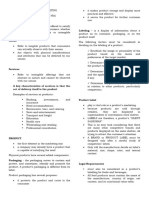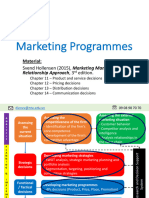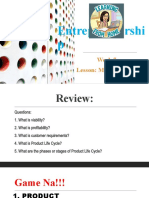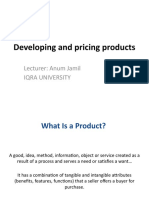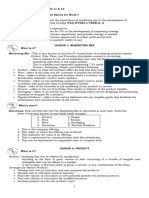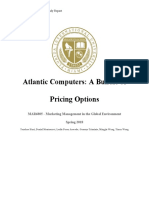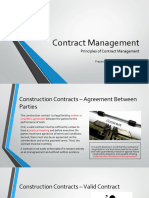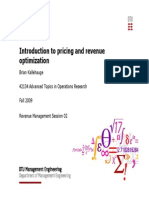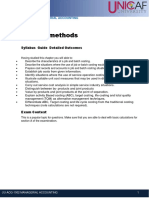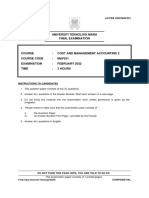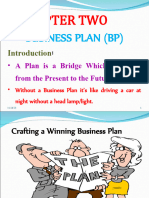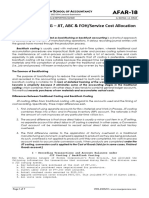Handout-Principles of Marketing (2nd Quarter)
Product - it is anything that can be offered to a domestic or an international market to satisfy the desire or
need of a customer.
ExperiencesRefers to the complete journey a customer takes with your brand, from initial awareness to
post-purchase care.
Two kinds of products:
1. GOODS – are sale of the physical products from the manufacturer to the consumer or end user. These
are tangible products that can measure the satisfaction after using it. Example: clothes, food, furniture and
appliances.
2. SERVICES – Servicesit refers to non physical products such as haircut, a foot spa service, a legal
service, doctors diagnosis, or any education given by public and private schools.
Both tangible and intangible goods and services can be further defined and divided into the following
groups:
1. Consumer Goods – items that are used directly by the end user such as food, clothing, cars,
etc.
2. Consumer Services – services that are for the benefit of end users
directly such as education, courier services, grooming services, etc.
3. Producer Goods – items that act as part of another company’s operations
such as machinery or parts.
4. Producer Services – services that support another company’s operations
such as accounting, human resource, etc.
PACKAGING
Packaging – it serves to secure and contain, and sometimes identify and promote the product.
Product packaging has several purposes:
LABELING
Labeling is defined as a display of information about a product on its containers, packaging or on
product itself. There are legal requirements that must be considered in product’s labeling for foods and
beverages.
Product Life Cycle:
The vital application for any product is the stages of its lifecycle. A typical product goes through
the following stages:
1. Introduction – slow growth period following product launch.
2. Growth – fast growth phase once the product is established.
3. Maturity – a period of slowdown in sales as the product becomes
universal in the market
4. Decline – A downward sales as the product is no longer fulfilling a need
or there are better options.
PRODUCT DEVELOPMENT PROCESS
Step 1: Idea generation – it is the first stage of new product development process in which several idea
generation techniques are used to generate as many new product ideas as possible.
�Step 2: Idea screening – it is the stage wherein ideas generated in the first step are screened using fixed
criteria to reduce them to a manageable few.
Step 3: Concept development and testing – new products ideas are converted into a customer-centered
products concepts and tested by a representative as a sample consumer for acceptability, believability and
purchase intent.
Step 4: Business analysis – is a stage wherein the probable sales of the new products are calculated
together with its cost and potential profitability based on the concept development and testing results.
Step 5: Product development – is a stage wherein the product concept is turned into a tangible working
prototype.
Step 6: Market testing – is a stage where the new product is marketed in a limited geographical area to
determine if the fine tuning of attributes, positioning, pricing, advertising and promotions are significant.
Step 7: Product commercialization – the final stage wherein the new product is launched in the market
Consumer products = Are those bought by consumers for their own personal or family use.
Are those bought by a firm or organization for its own use.
Durables = A types of products which have a long interval between repeat purchases because of their long
Lasting nature like tv and cars.
Services=Products which are essentially intangible because there are no physical items involved. Like
training Services, tent rentals and others.
DurablesProducts which have stronger repeat purcahases because they are consumable like detergents
Snacks and many more.
Price The amount of money a buyer pays to a seller in exchange for products and services.
=Is defined as the amount of money that you charge for your products.
= is the process whereby a business sets the price at which it will sell its products and services.
=Is a process of fixing the value that a manufacturer will receive in the exchange of services and
good
Pricing strategies It refers to the processes and methodologies businesses use to set prices for their
products and services.
If pricing is how much you charge for your products, then product pricing strategy is how you
determine what that amount should be.
Competitive pricingIs a price-setting that is based on your competitors' prices. This pricing method focuses
solely on the prices of your competitors.
Price skimming=Is a strategy often associated with profit maximization, includes also setting prices high
initially to appeal to customers who are not price sensitive.
Pricing Strategies It refers to the processes and methodologies businesses use to set prices for their
products and services .
Mark up pricing Is a pricing strategy that allows the seller to a fixed mark up everytime the product is sold.
Pricing Policies It is s a company's approach to determining the price at which it offers a good or service to
the market. It also help companies make sure they remain profitable and give them the
flexibility.
� 9 Approaches to Pricing Strategy: How to Price a Product
1. Channel Specific Pricing Strategy
is a type of retail pricing strategy that means you'll form your prices primarily based on the channel of sale,
the delivery method, and the channel's reach.
A channel strategy is a plan of action through which businesses make the product/service available to the
end user.
Example : Apple uses a dual distribution channel strategy i.e., selling to customers directly through its
stores and third-party mobile carriers.
2. Cost-plus Pricing Strategy
Cost-plus pricing is a basic pricing strategy that involves determining the cost of goods or services, and
then adding a fixed percentage (the margin) as the markup.
For example, if your total costs are $100 and you want a 20% profit margin, you would add $20 to arrive at
a selling price of $120
3. Value-based Pricing Strategy
Value-based pricing can help businesses stand out from their competitors by highlighting the unique
benefits of their products or services.
For example, a restaurant that sources local, organic ingredients may charge higher prices, distinguishing
itself from competitors that use conventional produce.
4. Dynamic Pricing Strategy
A pricing strategy that charges customers different prices for the same good
or service based on fluctuations in market demand. Businesses using dynamic pricing change their prices
in real time according to changes in supply and demand.
For example, if stock for a particular product drops on an e-commerce site like Amazon, you'll likely see a
surge in the price within minutes.
5. Competitive Pricing Strategy
Is a price-setting that is based on your competitors' prices. This pricing method focuses solely on the prices
of your competitors that are public, but it does not take into account how much customers value the product
or production costs.
Example : The rivalry between Coca-Cola and Pepsi is one of the most famous examples of competition-
based pricing. Both companies constantly monitor each other's pricing and promotional strategies and
adjust their prices accordingly to stay competitive.
6. Penetration Pricing Strategy = is a marketing strategy used by businesses to attract customers to a new
product or service by offering a lower price during its initial offering.
The lower price helps a new product or service penetrate the market and attract customers away from
competitors.
Market penetration pricing relies on the strategy of using low prices initially to make a wide number of
customers aware of a new product.
Examples Coca-Cola's approach to market penetration is underscored by product variations that
resonate with diverse consumer needs. Aiming to broaden its scope, the brand has diversified its
offerings, including Coke Zero, appealing to health-conscious consumers.
� 7. Skimming Pricing Strategy = A product pricing strategy by which a firm charges the highest initial price that
customers will pay. Over time, the price is lowered to attract more price-sensitive customer segments.
The strategy focuses on capturing early adopters who are willing to pay a premium for being the first
to own the product.
example Samsung’s 2020. flagship phone Galaxy S20. On the release day, the price of this smartphone was
$999. However, after the release of its new flagship smartphone, Galaxy S21, the price of the last
year’s phone significantly dropped and it could be found for the price of around $600 depending on
the store you are buying it from.
8. Economy Pricing Strategy = is a pricing strategy where products have lower prices due to low production
costs. Economy pricing allows businesses to price products according to their production value
because they don't acquire the extra costs of advertising or marketing.
Here are a few more examples of products that can benefit from economy pricing:
Supermarkets with their own brands.
Retail outlets.
Budget airlines.
Budget hotels and resorts
9. Premium Pricing Strategy= is a strategy that involves tactically pricing your company's product higher than
your immediate competition.
The purpose of pricing your product at a premium is to cultivate a sense of your product's market
being just that bit higher in quality than the rest.
Examples include expensive wines and spirits, luxury cars, bespoke firearms, brand-name watches,
and patented pharmaceutical drugs.
Distribution Channel =Performs the work of moving products from the manufacturer to final consumers or business
users.
Distribution (place)It aims to make products or services available to its target market consistent with their purchasing
pattern.
Distributors Are appointed to perform the distribution function for manufacturers in making their products
available.
Wholesaling Is the activity of persons or organizations that sell to those who buy for resale or business use .
RetailingIs an activity involving the sale of products or services directly to final consumer.
Business to business marketingIs also giving a different face to selling process as companies realize that substantial
money and time can be saved from the paperless e-market.
Home deliveryOffers a huge potential influenced by more woman working , lack of household maids as well as
consumer psyche of rewarding themselves for a hard days work.
diagnostic distributionUsing this term to mean the proper matching of distribution channels to the selling process.
� TYPES OF DISTRIBUTION CHANNEL
1. Direct distribution channels = refer to the method of selling products directly from the producer or manufacturer
to the end consumer without the involvement of intermediaries. In this channel, the producer
takes on the responsibility of marketing, sales, and distribution.
2. Indirect distribution channels = refer to the method of selling products where intermediaries, such as wholesalers,
retailers, distributors, agents, or brokers, are involved in the distribution process between the
producer and the consumer. These intermediaries handle tasks like warehousing,
transportation, marketing, and selling the products to the end customers.
3. Hybrid distribution channels = combine elements of both direct and indirect channels. It involves a combination
of selling products directly to consumers while also utilizing intermediaries to distribute and sell
products on behalf of the producer.
Here are the common levels of distribution channels:
1. Zero-level channel or direct marketing
In this there are no intermediaries involved between the producer and the end consumer. The producer
directly sells products to customers through methods such as company-owned online stores, direct
sales representatives, or physical outlets. This level of distribution provides the producer with maximum
control over the marketing and distribution process.
2. One-level channel or retail
In this channel there is one intermediary between the producer and the consumer. Typically, this
intermediary is a retailer who purchases products from the producer and sells them directly to customers.
Retailers can operate through physical stores, e-commerce platforms, or a combination of both.
3. Two-level channel or wholesale and retail = there are two intermediaries between the producer and the
consumer. The first intermediary is a wholesaler who purchases products in bulk from the producer and
sells them in smaller quantities to retailers. The second intermediary is the retailer who then sells the
products to the end consumer. Wholesalers help in distribution, storage, and breaking down larger
product quantities, while retailers focus on selling to individual customers.
4. Three-level channel or agent, wholesaler, and retailer = there are three intermediaries involved in the
distribution process. The first intermediary is an agent or broker who acts on behalf of the producer,
connecting them with wholesalers. The wholesalers purchase products from the producer and sell them
to retailers. Finally, the retailers sell the products to consumers. This channel structure is common in
industries where specialized agents or brokers assist in connecting producers with wholesalers.
What are the functions of distribution channels?
The functions of distribution channels involve a range of activities and tasks that facilitate the
efficient flow of products from the producer to the end consumer.
� Here are the key functions of distribution channels:
Product distribution
Market coverage
Inventory management
Order processing and fulfillment
Promotion and marketing
Market intelligence
After-sales service
Supply Chain It is a network of all the individuals, organizations, resources, activities and technology involved
in the creation and sale of the product.
ExclusiveType of distribution that is limited to a select number of dealers usually one or a few and to have more
control over how a particular brand is priced, displayed and promoted.
Intensive=This product distribution type, used mostly by fast moving consumer goods and convenience goods,
involves making a product available in as many retail outlets as possible.
WholesalingIs the sale of goods for resale. It is an important product distribution function. Without this product
manufacturers would have to deliver goods directly to retailers.
Supply Chain It includes the total sets of coordinated and timely activities and programs utilized by suppliers that
result in the production or creation of goods and the delivery of the same to the buyer
LogisticsIt is the coordination of the flow of useful and timely information goods and services among the
participants in the distribution channel.
ReturnsThe process is often called reverse logistics, and the company must ensure it has the capabilities to
receive returned products and correctly assign refunds for them.
PlanningTo get the best results from SCM, the process usually begins here to match supply with customer and
manufacturing demands. Companies must try to predict what their future needs will be and act
accordingly.
DeliveryOnce products are made and sales are finalized, a company must get those products into the hands of
its customers.
SourcingEffective Supply Chain Management processes rely very heavily on strong relationships with suppliers.
It entails working with vendors to supply the materials needed throughout the manufacturing
process.
ManufacturingUsing machinery and labor to transform the raw materials or components the company has received
from its suppliers into something new is the heart of the supply chain management process.
What Is Supply Chain Management (SCM)?
Supply chain management (SCM) is the monitoring and optimization of the production and
distribution of a company’s products and services. It seeks to improve and make more efficient
all processes involved in turning raw materials and components into final products and getting
them to the ultimate customer. Effective SCM can help streamline a company's activities to
eliminate waste, maximize customer value, and gain a competitive advantage in the
marketplace.
� 5 Phases of Supply Chain Management (SCM)
1. Planning
To get the best results from SCM, the process usually begins with planning to match supply
with customer and manufacturing demands.
2. Sourcing
Effective SCM processes rely very heavily on strong relationships with suppliers. Sourcing
entails working with vendors to supply the materials needed throughout the manufacturing
process.
3. Manufacturing
Using machinery and labor to transform the raw materials or components the company has
received from its suppliers into something new is the heart of the supply chain management
process. This final product is the ultimate goal of the manufacturing process, though it is not
the final stage of SCM
4. Delivery
Once products are made and sales are finalized, a company must get those products into the
hands of its customers. A company with effective SCM will have robust logistic capabilities and
delivery channels to ensure timely, safe, and inexpensive delivery of its products.
5. Returns
The SCM process concludes with support for the product and customer returns.
The return process is often called reverse logistics, and the company must ensure it has the
capabilities to receive returned products and correctly assign refunds for them. Whether a
company is conducting a product recall or a customer is simply not satisfied with the product,
the transaction with the customer must be remedied
AdvertisingAny paid and public presentation of products, services or ideas by an identified sponsor through a
medium.
Promotional ToolsAre strategies, methods or resources that compel consumers to buy a product or service
ExperimentalAttempts to promote brands using high sensory value. It satisfies customer’s desire for products
FunctionalIt is Attempts to provide a product brand as the solution to a currents consumption problem experience
by customers.
Symbolic Attempts to associate brand ownership with an aspirational group. It addresses other abstract need
states that involves aspects not addressed by finctional products benefits.
Personal SellingOccurs when an individual salesperson sells a product, services or solution to a client.
� PromotionsAre activities or a series of activities, usually short term, that are intended to boost the sales of a
product or services.
PublicityIs a communication written and produced by public relations professionals intended to create a favorable
public image for a client.
Public RelationsIs creating and maintaining goodwill of an organization’s various customers, employees, investors
And others through publicity and other non paid forms of communication.
RadioA viable advertising vehicle in the Philippines since 1922, it is the most accessible media.
.Billboard The relatively low cost but high exposure to heavy traffic along major thoroughfares have led to the
Popularity of this advertisement.
. Website = A types of media almost all legitimate companies have developed that customers can access for
Product information and services.
. Transit AdvertisingBuses and jeepneys in the Philippines ply the same route everyday. An advertising sinage
on the Side or back of a bus, jeepney spare tire cover, or percged a top of taxicab can create good brand
Recall for the market.
. Brand Advertising Aims to stimulate demand for a particular brand. Examples are the advertisements for
telecom service provides that we see almost daily from Globe and Smart.
Classified AdverstingAims to inform prospects regarding opportunities such as buy and sell, events and
employment, used to be dominated by Manila Bulletin.
Institutional Advertising Which Aims to develop goodwill for a company or industry. An example is the Pagcor
advertisement about responsible gaming and their various charity projects.
Swot Analysis Internally and Externally focused and compared against the key factors for success of other
Companies in the industry.
B. Write the letter corresponding to the correct answer for each of the questions provided below
A. Internal Factors Affect Pricing Decision
Product Life Cycle.
Image of the Firm.
External Factors Affect Pricing Decision
Cost.
Marketing Mix Strategy.
Pricing
B. External Factors Affect Pricing Decision
Government Regulated Economy
Consumers/ Customers
Competition.
Economic terms and conditions.
Prepared By: Imelda F. Sanosa.MBA
















